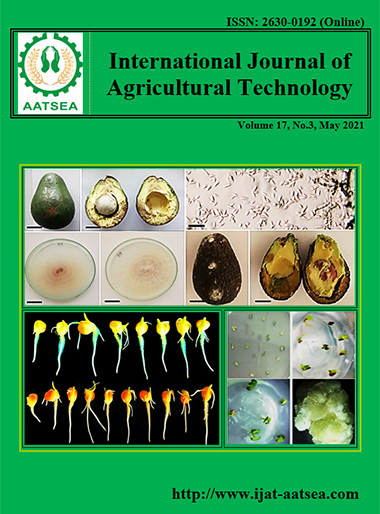Effects of cultivated practices on the growth, phenolic content, antioxidant activity and Ca content of Chinese kale (Brassica oleracea L. var. alboglabra)
Main Article Content
Abstract
Various cultivation practices did not significantly increase the total phenol content (TPC), antioxidant activity (AA), and calcium (Ca) content in Chinese kale (Brassica oleracea). The results indicated that conventional cultivation (CC), good agricultural practice (GAP), and local plant bioextract (LPB) significantly gave the highest leaves chlorophyll content at 23 and 48 days after seed sowing (DASS), fresh weight/m2, and leaves width compared to the controlled treatment. The highest leaves length was affected by GAP and LPB, where the highest petiole length was affected by GAP compared to other treatments. The TPC, AA and Ca content were not affected by any cultivation practices. These results implied that cultivation practices influenced some growth traits of B. loeracea but did not influence the TPC, AA and Ca content
Article Details

This work is licensed under a Creative Commons Attribution-NonCommercial-NoDerivatives 4.0 International License.
References
Adom, K. K. and Liu, R. H. (2002). Antioxidant activity of grains. Journal of Agricultural and Food Chemistry, 50:6182-6187.
Ahmed, A. G., Orabi, A. G. S. and Gomaa, A. M. (2010). Bio-organic farming of grain sorghum and its effect on growth, physiological and yield parameters and antioxidant enzymes activity. Research Journal of Agriculture and Biological Science, 6:270-279.
Arteca, R. N. (1996). Plant growth substances : principles and applications. New York, Chapman & Hall.
Bojovic, B. and Stojanovic, J. (2005). Chlorophyll and carotenoid content in wheat cultivars as a function of mineral nutrition. Archives of Biological Science, 57:283-290.
Brand-Williams, W., Cuvelier, M. E. and Berset, C. (1995). Use of a free radical method to evaluate antioxidant activity. LWT-Food Science and Technology, 28:25-30.
Bravo, L. (1998). Polyphenols : chemistry, dietary sources, metabolism, and nutritional significance. Nutrition Reviews, 56:317-333.
Bray, R. H. and Kurtz, L. T. (1945). Determination of total organic and available forms of phosphorus in soils. Soil Science, 59:39-46.
Daughtry, C. S. T., Walthall, C. L., Kim, M. S., Brown de Colstoun, E. and McMurtrey. (2000). Estimating corn leaf chlorophyll concentration from leaf and canopy reflectance. Remote Sensing of Environment, 74:229-239.
Folin, O. and Ciocalteu, V. (1927). On tyrosine and tryptophane determinations in protein. The Journal of Biological Chemistry, 73:627-650.
Hanlon, E. A. (1998). Elemental determination by atomic absorption spectrophotometry. In : Kalra, Y. P. ed. Handbook of reference methods for plant analysis, Boca Raton, FL, CRC Press, pp.157-164.
Kesarvani, A., Chiang, P. Y. and Chen, S-S. (2014). Distribution of phenolic compounds and antioxidative activities of rice kernel and their ralationships with agronomic practice. The Scientific World Journal, 2014:620171.DOI10.1155/2014/620171.
Land Development Department (2004). Manual of sample analysis for soil, water, fertilizer, plant, soil conditioner and certified goods standard. Bangkok, Office of Science for Land Development.
Land Development Department (2010). Manual of soil chemical analysis procedure. Retrieved from http://www.ldd.go.th/PMQA/2553/ Manual/OSD-03.pdf.
LECO Corporation (2018). Operation In : Trumac 828 series carbon/nitrogen analyzer instruction manual. LECO Europe B.V., U.S., pp.3-48.
Lindsay, W. L. and Norvell, W. A. (1978). Development of a DTPA soil test for zinc, iron, manganese and copper. Soil Science Society of America Journal, 42:421-428.
Lu, Z., Lu, J., Pan, Y., Lu, P., Li, X., Cong, R. and Ren, T. (2016). Anatomical variation of mesophyll conductance under potassium deficiency has a vital role in determining leaf photosynthesis : structural controls on gm under K deficiency. Plant Cell Environment, 39:2428-2439.
Marschner, H. (1995). Mineral nutrition of higher plants. 2nd ed. London, Academic Press.
Naprom, D. and Sringam, K. (2009). Training manual for analytical technique of plant hormones. Chiangmai, Chiangmai University.
Prasoprattanachai, A. (2009). Antioxidant Activities of Organically-Grown Vegetable Extracts. (Master Thesis). Maejo University, Thailand.
Ren, F., Reilly, K., Gaffney, M., Kerry, J. P., Hossain, M. and Rai, D. K. (2017). Evaluation of polyphenolic content and antioxidant activity in two onion varieties grown under organic and conventional production systems. Journal of the Science of Food and Agriculture, 97:2982-2990.
Sakunasing, P. (2009). Difference of Antimutagenicity Against Urethane between Conventionally and Organically Grown Cruciferous Vegetables (BRASSICA SPP.). (Master Thesis) Mahidol University, Thailand.
Sun, B., Liu, N., Zhao, Y., Yan, H. and Wang, Q. (2011). Variation of glucosinolates in three edible parts of chinese kale (Brassica alboglabra Bailey) varieties. Food chemistry, 124:941-947.
Sun, B., Yan, H., Zhang, F. and Wang, Q. (2012). Effects of plants hormones on main health–promoting compounds and antioxidant capacity of Chinese kale. Food Research International, 48:359-366.
Suwanawong, S. (2001). Analysis of plant nutrition. Bangkok, Kasetsart University Press.
Theerachindakhajorn, P. (2011). Handbook of soil chemical analysis. Khon Kaen, Khon Kaen University Press.
Toyota Thailand Foundation and Mahidol University (1997). The miracle of veggies 108. Bangkok, Kobfai, pp.144-146.
Tripathi, D. K., Singh, S., Singh, S. and Mishra, S. (2015). Micronutrients and their diverse role in agricultural crops : advances and future prospective. Acta Physiologiae Plantarum, 37:139. DOI 10.1007/s 11738-015-1870-3.
Walkley, A. and Black, I. A. (1947). Chromic acid titration method for determination of soil organic matter. Soil Science Society of America Proceedings, 63:257.
Wang, Y. Q., Hu, L. P., Liu, G. M., Zhang, D. S. and He, H. J. (2017). Evaluation of the nutritional quality of Chinese kale (Brassica alboglabra Bailey) using UHPLC-Quadrupole-Orbitrap MS/MS-Based metabolomics. Molecules, 22:1262.
Zhao, X., Du, Q., Zhao, Y., Wang, H., Li, Y., Wang, X. and Yu, H. (2016). Effects of different potassium stress on leaf photosynthesis and chlorophyll fluorescence in maize (Zea mays L.) at seedling stage. Agricultural Science, 7:44-53.


